Pride & Prejudice - Movie Review
 Pride & Prejudice 2005
Pride & Prejudice 2005First, a history lesson. Relax, you mooks, it won’t take long. When we first heard there was to be a new film version of Jane Austen’s “Pride & Prejudice” we too jumped the gun and thought, oh dearest us, not another one! Well, we must take that back, ‘cause in our research – you do realize we do research, we’re not just flying by the seat of our Diesels® kinda hack entertainment journalists ya know, anywho in our research we discovered that this latest incarnation would be the first cinematic straight adaptation of “P&P” since MGM’s glittering 1940 version. What!! But what about the lovely 1995 BBC version starring Jennifer Ehle and Colin Firth and countless others? Well, if you actually paid attention, there have been umpteen versions made strictly for television, as either a movie or mini-series. And we’re talking about the big screen, you dolts. And we’re not counting any modernized adaptations or the Wog version. As much as we love our mini-series, it would be completely ignorant and foolish of us to compare one to a big screen adaptation. The medium is entirely different. What one can do with two, three, four or seventeen episodes is radically different than choosing to adapt a piece of literature to the major motion picture screen. So there. Nyah!
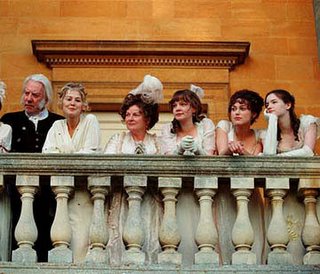 Now, back to the latest version. As many Jane Austen nutjobs . . . er, fans will tell you, “Pride & Prejudice” tells the tale of a down on their shillings family, the Bennets whose father and in particular, mother are simply mad to marry off their gaggle of five daughters to decent, respectable, and hopefully filthy rich bachelors. Very pro-woman, this piece. The eldest daughter, Elizabeth is the “headstrong” (Read: uptight twat) one who fancies nothing more than enjoying the simple rustic charms of semi-poverty and an occasional good potboiler. Her sister Jane is the “pretty one” (Read: horny slut), who would like nothing better than to marry the rich, eligible new neighbor. The next two bitches are Lydia and Kitty who are basically the Paris and Nicole of their day. And then there’s the ugly lesbian daughter, Mary.
Now, back to the latest version. As many Jane Austen nutjobs . . . er, fans will tell you, “Pride & Prejudice” tells the tale of a down on their shillings family, the Bennets whose father and in particular, mother are simply mad to marry off their gaggle of five daughters to decent, respectable, and hopefully filthy rich bachelors. Very pro-woman, this piece. The eldest daughter, Elizabeth is the “headstrong” (Read: uptight twat) one who fancies nothing more than enjoying the simple rustic charms of semi-poverty and an occasional good potboiler. Her sister Jane is the “pretty one” (Read: horny slut), who would like nothing better than to marry the rich, eligible new neighbor. The next two bitches are Lydia and Kitty who are basically the Paris and Nicole of their day. And then there’s the ugly lesbian daughter, Mary. Into their drab little dilapidated country estate . . . how quaint, arrive two eligible rich bachelors (Imagine! What luck!), the eager to please Mr. Bingley, and the brooding and aloof Mr. Darcy. With some Cruella de Ville type in tow . . . (We blocked her out, she was played so “Saturday Afternoon Serial Villainess”ish.) Jane (the horny slut) falls in love with Mr. Bingley, Elizabeth (the uptight twat) is offended by Mr. Darcy, their mother is foaming at the mouth at the thought of one of her daughters finally getting hitched and the romp begins.
Into their drab little dilapidated country estate . . . how quaint, arrive two eligible rich bachelors (Imagine! What luck!), the eager to please Mr. Bingley, and the brooding and aloof Mr. Darcy. With some Cruella de Ville type in tow . . . (We blocked her out, she was played so “Saturday Afternoon Serial Villainess”ish.) Jane (the horny slut) falls in love with Mr. Bingley, Elizabeth (the uptight twat) is offended by Mr. Darcy, their mother is foaming at the mouth at the thought of one of her daughters finally getting hitched and the romp begins. Now, we wouldn’t dream of spoiling the plot twists and turns and surprise ending. (Mr. Darcy turns out to be wonderful, Elizabeth was wrong about him the entire time – he was too PROUD and she was too consumed with PREJUDICE, and they get married and live happily ever after.) Except to say if that if you have either read “Bridget Jones’s Diary” or hell, any piece of literature above the “Curious George” level, you pretty much know what is going to happen. And that really isn’t the point with Jane Austen anyway. The beauty of Jane Austen is in her ability to combine romantic comedy with social satire and great character studies. One should only hope that those three simple staples of La Austen’s work will shine thru in any big screen adaptation. They did. In 1940. Starring Greer Garson, Laurence Olivier, Maureen O’Sullivan, Heather Angel, Ann Rutherford, Mary Boland, Edmund Gwenn, and Edna May Oliver. It was directed by the prolific Robert Z. Leonard and co-adapted by the great novelist Aldous Huxley. And while it may not be on par with “Citizen Kane” or “8 ½” as one of the greatest films ever made, it is justifiably regarded as a delightful cinematic soufflé.
Now, we wouldn’t dream of spoiling the plot twists and turns and surprise ending. (Mr. Darcy turns out to be wonderful, Elizabeth was wrong about him the entire time – he was too PROUD and she was too consumed with PREJUDICE, and they get married and live happily ever after.) Except to say if that if you have either read “Bridget Jones’s Diary” or hell, any piece of literature above the “Curious George” level, you pretty much know what is going to happen. And that really isn’t the point with Jane Austen anyway. The beauty of Jane Austen is in her ability to combine romantic comedy with social satire and great character studies. One should only hope that those three simple staples of La Austen’s work will shine thru in any big screen adaptation. They did. In 1940. Starring Greer Garson, Laurence Olivier, Maureen O’Sullivan, Heather Angel, Ann Rutherford, Mary Boland, Edmund Gwenn, and Edna May Oliver. It was directed by the prolific Robert Z. Leonard and co-adapted by the great novelist Aldous Huxley. And while it may not be on par with “Citizen Kane” or “8 ½” as one of the greatest films ever made, it is justifiably regarded as a delightful cinematic soufflé.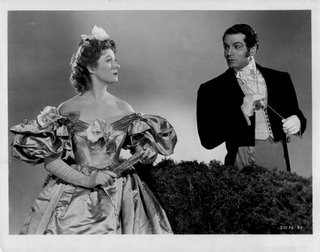 This latest version would be better compared to a cinematic scone that one dropped on the floor and dusted off and laid back on the dirty plate. There is nothing hideously wrong with this adaptation, if you don’t count half the casting, the screenplay and the horrendous cinematography. We have to pause and say that it has been years since the cinematography alone has ruined a movie for us, but the work done here by one Roman Osin is unworthy of being labeled “lazy” or “horrendous”. That would be too kind.
This latest version would be better compared to a cinematic scone that one dropped on the floor and dusted off and laid back on the dirty plate. There is nothing hideously wrong with this adaptation, if you don’t count half the casting, the screenplay and the horrendous cinematography. We have to pause and say that it has been years since the cinematography alone has ruined a movie for us, but the work done here by one Roman Osin is unworthy of being labeled “lazy” or “horrendous”. That would be too kind. On the plus side, the casting scores high marks for the brooding charms of Matthew MacFadyen as Mr. Darcy (God! What a voice!), the comic timing of Tom Hollander as Mr. Collins, and the polished and touchingly effective work done by three veterans: Donald Sutherland as Mr. Bennet, Judi Dench as Lady Catherine de Bourg, and the brilliant Brenda Blethyn as Mrs. Bennet. They almost saved the movie for us. Almost. If we could have seen them thru the muddy and hideously lit cinematography. The screenplay by one Deborah Moggach is pedestrian at best, and cloyingly attempts at some degree of modernity when it would have been better to emulate the Oscar winning screenplay by Emma Thompson for the fabulous Ang Lee adaptation of Jane Austen’s “Sense & Sensibility.” Rumor has it that the great Emma did a rewrite on this latest flick but refused any credit for it. She was right in not allowing her name to be besmirched. We can credit her for the good lines. Because we’re generous.
On the plus side, the casting scores high marks for the brooding charms of Matthew MacFadyen as Mr. Darcy (God! What a voice!), the comic timing of Tom Hollander as Mr. Collins, and the polished and touchingly effective work done by three veterans: Donald Sutherland as Mr. Bennet, Judi Dench as Lady Catherine de Bourg, and the brilliant Brenda Blethyn as Mrs. Bennet. They almost saved the movie for us. Almost. If we could have seen them thru the muddy and hideously lit cinematography. The screenplay by one Deborah Moggach is pedestrian at best, and cloyingly attempts at some degree of modernity when it would have been better to emulate the Oscar winning screenplay by Emma Thompson for the fabulous Ang Lee adaptation of Jane Austen’s “Sense & Sensibility.” Rumor has it that the great Emma did a rewrite on this latest flick but refused any credit for it. She was right in not allowing her name to be besmirched. We can credit her for the good lines. Because we’re generous.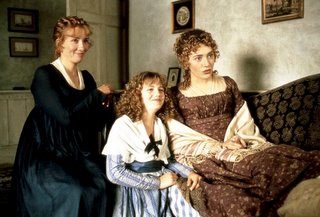 But the real problem lies in the casting of the kewpie doll Keira Knightley as Elizabeth Bennet. While Keira may have appeared in some successful films like “Bend It Like Beckham” “Pirates of the Caribbean: The Curse of the Black Pearl” and “Love Actually” she is not exactly known for her gifted handling of period dialogue. And boy howdy, does it show. While her tomboyish attitude may be slightly in synch with Elizabeth Bennet’s headstrong character traits, her inability to utter “Good Day, Mr. Darcy” without coming across as a twenty year old tart from Middlesex is not. We grant you that Miss Knightley is a lovely young bint, but one could hardly tell with THE FUCKING HIDEOUS CINEMATOGRAPHY!!!
But the real problem lies in the casting of the kewpie doll Keira Knightley as Elizabeth Bennet. While Keira may have appeared in some successful films like “Bend It Like Beckham” “Pirates of the Caribbean: The Curse of the Black Pearl” and “Love Actually” she is not exactly known for her gifted handling of period dialogue. And boy howdy, does it show. While her tomboyish attitude may be slightly in synch with Elizabeth Bennet’s headstrong character traits, her inability to utter “Good Day, Mr. Darcy” without coming across as a twenty year old tart from Middlesex is not. We grant you that Miss Knightley is a lovely young bint, but one could hardly tell with THE FUCKING HIDEOUS CINEMATOGRAPHY!!! Jesus H. Christ on a bed of arugula! What the fuck was director Joe Wright thinking of? And by the way, who the fuck is Joe Wright? Yo Wrong is more like it. What truly angered us with this piece is that we actually enjoyed several of the scene set-ups and we thought that the two ball sequences were staged with a graceful ingenuity we found quite refreshing. If we could only have SEEN THE FUCKING ACTORS!!!! This film should be taught in all film schools to demonstrate how bad cinematography can ruin interesting camerawork. Apparently, Roman Osin believes in lighting a scene in only one fashion. Harshly. Now we don’t expect every film, let alone every period film to be “Barry Lyndon”, we just would like to be able to think of Keira Knightley as something other that “Fat Face.” There, that got you, didn’t it? Obviously anybody who has ever seen Miss Knightley onscreen can tell you that she is anything but “Fat.” In fact, with her whippet thin frame and the clunky boots she sports under her empire waisted nightgown, she resembles one of the Olsen twins jotting out to the nearest Starbucks® for some Grade A Columbian finest, and a cup of coffee.
Jesus H. Christ on a bed of arugula! What the fuck was director Joe Wright thinking of? And by the way, who the fuck is Joe Wright? Yo Wrong is more like it. What truly angered us with this piece is that we actually enjoyed several of the scene set-ups and we thought that the two ball sequences were staged with a graceful ingenuity we found quite refreshing. If we could only have SEEN THE FUCKING ACTORS!!!! This film should be taught in all film schools to demonstrate how bad cinematography can ruin interesting camerawork. Apparently, Roman Osin believes in lighting a scene in only one fashion. Harshly. Now we don’t expect every film, let alone every period film to be “Barry Lyndon”, we just would like to be able to think of Keira Knightley as something other that “Fat Face.” There, that got you, didn’t it? Obviously anybody who has ever seen Miss Knightley onscreen can tell you that she is anything but “Fat.” In fact, with her whippet thin frame and the clunky boots she sports under her empire waisted nightgown, she resembles one of the Olsen twins jotting out to the nearest Starbucks® for some Grade A Columbian finest, and a cup of coffee.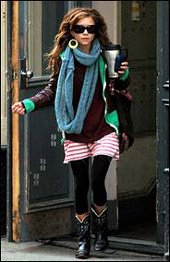
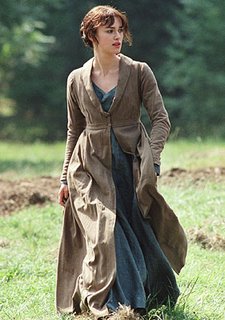 You don’t get thinner than that, kids. The close-ups of Keira were the deal breaker for us. If this wog can’t light a beautiful young lady like Keira, what hope do they have of establishing any kind of atmosphere or mood? None. That’s what.
You don’t get thinner than that, kids. The close-ups of Keira were the deal breaker for us. If this wog can’t light a beautiful young lady like Keira, what hope do they have of establishing any kind of atmosphere or mood? None. That’s what.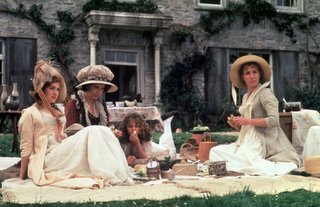 So, in closing – despite our yearning to be entertained by an intelligent romantic comedy, all we got for our money was eye-strain and a desire to go rent “Sense & Sensibility.” Now, THAT film has good lighting. Bless you all!
So, in closing – despite our yearning to be entertained by an intelligent romantic comedy, all we got for our money was eye-strain and a desire to go rent “Sense & Sensibility.” Now, THAT film has good lighting. Bless you all!(Closing History Lesson: We were recently in our salle de bain, pinching a loaf when we happened to read this quote from the November 18th edition of EW (Perfectly named - we might add) magazine. They were attempting to compare the 1940, 1995 BBC, and current versions. (What did we tell you about that! Read the opening paragraph again.) Anywho, this moron goes on to comment on our beloved 1940 MGM version, and we quote: “The costumes look off by several decades, as if they were swiped from the set of 1939’s “Gone With the Wind”. Now listen, you cross eyed git, the costumes for the lovely 1940 version were by the legendary Adrian who deliberately set the film at the height of the Romantic Era circa 1830s to take full advantage of the dashing male silhouette and the flouncy charm of the Gigot de Mouton sleeves. “Gone With the Wind” was brilliantly designed by Walter Plunkett, who set the opening scenes in the Crinoline Era of the 1860s thru the Bustle Period of the 1870s. Get your fucking facts right, you ignorant hack! Peace, love and light!)
Directed by Joe Wright
Written by Deborah Moggach
Based on the book by Jane Austen
Starring
Keira Knightley as Elizabeth Bennet
Matthew MacFadyen as Mr. Darcy
Judi Dench as Lady Catherine de Bourg
Rosamund Pike as Jane Bennet
Jena Malone as Lydia Bennet
Carey Mulligan as Kitty Bennet
Talulah Riley as Mary Bennet
Brenda Blethyn as Mrs. Bennet
Donald Sutherland as Mr. Bennet
Tom Hollander as Mr. Collins
Rupert Friend as Mr. Wickham
Cinematography by Roman Osin
Film Editing by Paul Tothill
Costume Design by Jacqueline Durran
Original Music by Darioi Marianelli
Production Design by Sarah Greenwood
Art Direction by Nick Gottschalk & Mark Swain
Set Decoration by Katie Spencer


<< Home